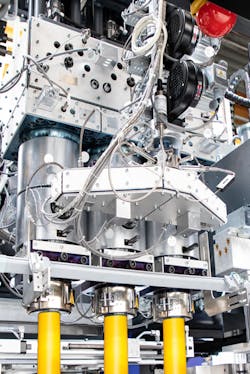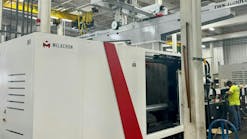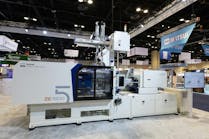Kautex Maschinenbau GmbH, Bonn, Germany, will unveil a new line of premium blow molding die heads in October, said Paulo Gomes, global director of strategic business marketing.
Kautex manufactures extrusion blow molding machines and die heads.
The new die heads are designed to meet customer demands for increased sustainability, greater operational efficiency, better color management, faster color changes, more precise thickness control and reduced product weight.
“That was the underlying driver that led us to focus more and more on the die head,” Gomes said. “What we’ve done is taken a bit of a scientific approach … [Until now,] it was more of a trial-and-error process where we would try a design, make a concept, test the concept, get feedback and then optimize the concept.
“This time, what we did was use polymer science and then simulation tools to understand first what was happening today and understand the mechanisms that were leading to a poor color change performance or a non-ideal thickness distribution on the parison, and then from that point on, we started modeling the iterations of improvement on the die head.”
To make the die heads, Kautex creates virtual models using computer-aided engineering (CAE) tools, then tests the models to see how the die heads might perform. So far, it has piloted the die heads with a small number of companies.
“Based on that virtual model, we are able to make changes and improvements much faster and with reduced costs,” Gomes said. “That’s because it’s just modeling work at a computer and does not involve physical execution of a die head, going into a production hall and making a meaningful test in this real environment with a customer … That’s very cost-intensive because it’s production hours. It’s our own support time. It’s our own development afterward. It’s our customer’s time.”
Kautex can work out 90 percent of the bugs in die head development using CAE tools and leave manufacturing of test die heads to the very end of the process. One area in which computer modeling can boost efficiency is in reducing stagnation points that can hold resin and delay color changes.
“The savings is basically on the time it takes to go from good part to good part — this is the metric that we are taking,” Gomes said. “Typically, what the industry does is they make a small adjustment to the process parameters during a color change. From that point on, you produce products until you are able to actually validate the color change, and this is something that can last hours of production. Meaning that afterward, you need to make up for the loss of production time and you have to handle the regrind produced during color change.”
Die heads designed with CAE tools can significantly reduce the amount of scrap produced before the color change can be validated, he said.
Kautex has not yet announced a name for the premium line of die heads. Building die heads with this improved performance will add slightly to their cost, but most customers should save money in the long run because of reduced costs associated with testing die heads under development, reduced scrap production and more precise thickness control that results in overall lighter-weight products that require less resin.
“I wouldn’t call it lightweighting,” Gomes said. “This is a term that at Kautex we’re trying to introduce internally first, but we expect the market to pick it up, which is ‘right weighting.’ Lightweighting implies that lighter is always better, and we don’t necessarily agree with that.”
Plastic packaging must protect the contents it is surrounding, whether it is bottled water, oil, chemicals, or something else, Gomes said. If packaging is so lightweight that it no longer offers adequate protection, it’s not sustainable because the waste generated will be far greater than any savings obtained by the lightweighting.
“At Kautex, we’re more interested in right weighting, meaning putting thickness and plastic grams where they actually are needed and not excessive plastic in areas of the container where they’re actually not needed.” Gomes said. “That means that, overall, we can reduce the weight of the container without compromising the functionality of the packaging.”
Kautex is using a combination of commercially available CAE tools, proprietary tools and experience, Gomes said.
Some customers, for example those that do not require frequent color changes or that manufacture uniformly thick products, might not see significant cost savings from the new premium line. For those customers, Kautex will continue offering its existing die heads, Gomes said.
Bruce Geisleman, senior staff reporter
Contact
Kautex Machines Inc., North Branch, N.J., 908-252-9350, www.kautex-group.com
Bruce Geiselman | Senior Staff Reporter
Senior Staff Reporter Bruce Geiselman covers extrusion, blow molding, additive manufacturing, automation and end markets including automotive and packaging. He also writes features, including In Other Words and Problem Solved, for Plastics Machinery & Manufacturing, Plastics Recycling and The Journal of Blow Molding. He has extensive experience in daily and magazine journalism.






